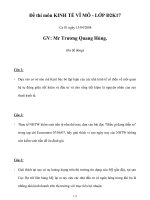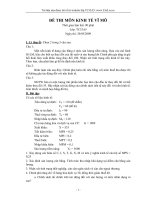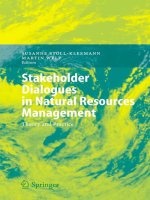Dề thi môn vi mô, microeconomic, microeconomic in natural resources management
Bạn đang xem bản rút gọn của tài liệu. Xem và tải ngay bản đầy đủ của tài liệu tại đây (7.44 MB, 106 trang )
TOPIC 1
CORE ISSUES
Core issues
When you have completed your
study of this topic, you will be able to
1
CHECKLIST
1 Define economics and explain the questions that economists
try to answer.
2 Explain the core ideas that define the economic way of
thinking.
1
CHECKLIST
When you have completed your
study of this topic, you will be able to
3 Explain and illustrate the concepts of scarcity,
production efficiency, and tradeoff using the production
possibilities frontier.
4 Calculate opportunity cost.
5 Explain what makes production possibilities expand.
1
CHECKLIST
When you have completed your study
of this topic, you will be able to
6 Describe what, how, and for whom goods and services
are produced in Vietnam; and in the global economy.
7 Use the circular flow model to provide a picture of how
households, firms, and governments interact.
1.1 DEFINITION AND QUESTIONS
! Economics is the study of
A. money
B. stock market
C. the economy
D. choice
1.1 DEFINITION AND QUESTIONS
All economic questions and problems arise because human
wants exceed the resources available to satisfy them.
! Scarcity
Scarcity is the condition that arises because wants exceeds
the ability of resources to satisfy them.
Faced with scarcity, we must make choices—we must choose
among the available alternatives.
The choices we make depend on the incentives we face.
1.1 DEFINITION AND QUESTIONS
! In economics, scarcity means that:
A. A shortage of a particular good will cause the
price to fall.
B. A production-possibilities curve cannot accurately
represent the tradeoff between two goods.
C. Society's desires exceed the want-satisfying
capability of the resources available to satisfy those
desires.
D. The market mechanism has failed.
1.1 DEFINITION AND QUESTIONS
! Economics Defined
Economics is the social science that studies the choices that
individuals, businesses, governments, and entire societies
make as they cope with scarcity, the incentives that influence
those choices, and the arrangements that coordinate them.
Two big economic questions:
• How do choices determine what, how, and for whom
goods and services get produced?
• When do choices made in self-interest also promote the
social interest?
1.1 DEFINITION AND QUESTIONS
! What, How, and For Whom?
Goods and services are the objects (goods) and actions
(services) that people value and produce to satisfy human
wants.
What goods and services get produced and in what
quantities?
How are goods and services produced?
For Whom are the various goods and services produced?
1.1 DEFINITION AND QUESTIONS
! When Is the Pursuit of Self-Interest in the
Social Interest?
- The choices that are best for the individual who makes
them are choices made in the pursuit of self-interest.
(for example: firm’s interest is likely its profit,
consumer’s interest is generally referred to his utility)
- The choices that are best for society as a whole are
choices made in the social interest.
1.1 DEFINITION AND QUESTIONS
Can choices made in self-interest also serve the
social interest?
1.2 THE ECONOMIC WAY OF THINKING
! Core Economic Ideas:
• Rational choice
• Cost
• Benefit
• Margin
• Incentives
1.2 THE ECONOMIC WAY OF THINKING
! Rational Choice
A rational choice is a choice that uses the available
resources to best achieve the objective of the person making
the choice.
We make rational choices by comparing costs and benefits.
1.2 THE ECONOMIC WAY OF THINKING
! Cost: What You Must Give Up
Opportunity cost is the best thing that you must give up
to get something—the highest-valued alternative forgone.
Sunk cost is a previously incurred and irreversible cost.
A sunk cost is not part of the opportunity cost of a current
choice.
1.2 THE ECONOMIC WAY OF THINKING
! Benefit: Gain Measured by What You Are Willing
to Give Up
Benefit is the gain or pleasure that something brings.
! On the Margin
A choice made on the margin is a choice made by
comparing all the relevant alternatives systematically and
incrementally.
1.2 THE ECONOMIC WAY OF THINKING
Marginal Cost
Marginal cost is the cost of a one-unit increase in an
activity.
Marginal Benefit
Marginal benefit is the what you gain when you get
one more unit of something.
1.2 THE ECONOMIC WAY OF THINKING
Making a Rational Choice
When we take those actions for which marginal benefit
exceeds or equals marginal cost.
! Responding to Incentives
An incentive is a reward or a penalty—a “carrot” or a
“stick”—that encourages or discourages an action.
1.2 THE ECONOMIC WAY OF THINKING
! Micro and Macro Views of the World
Microeconomics: The study of the choices that individuals
and businesses make and the way these choices interact and
are influenced by governments.
Macroeconomics: The study of the aggregate (or total)
effects on the national economy and the global economy of
the choices that individuals, businesses, and governments
make.
Players in the economy
Governments
Business
Firms
Consumers
International
participants
1.2 THE ECONOMIC WAY OF THINKING
! Economics as a Social Science
Economists distinguish between
• Positive statements: What is
• Normative statements: What ought to be
The task of economic science:
To test positive statements about how the economic world
works and to weed out those that are wrong.
1.2 THE ECONOMIC WAY OF THINKING
Unscrambling Cause and Effect
The central idea that economists use to unscramble cause and
effect is ceteris paribus.
Ceteris paribus means “other things being equal” or “other
things remaining the same.”
By changing one factor at a time and holding other relevant
factors constant, we are able to investigate the effects of the
factor.
EYE ONS
Is wind power
free?
The first wind farm in
Vietnam went into
operation is the project
in Binh Thuan province.
But what would be the
cost—the opportunity
cost—of that electricity?
1.3 PRODUCTION POSSIBILITIES
! Production Possibilities Frontier
– Production possibilities frontier
– The boundary between the combinations of goods and
services that can be produced and the combinations that
cannot be produced, given the available factors of production
and the state of technology.
– The PPF is a valuable tool for illustrating the effects of
scarcity and its consequences.
1.3 PRODUCTION POSSIBILITIES
Figure 3.1 shows
the PPF for cell
phones and DVDs.
Each point on the
graph represents a
column of the table.
The line through the
points is the PPF.









